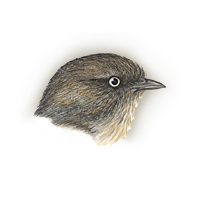|
Field
Guide IDs: BREEDING:
Chaparral, scrub,
well planted suburban areas. 2? broods. DISPLAYS:
? NEST:
Base of cobwebs
supporting coarse bark, with deep cup of fine bark,
lined with fine fibers, hair. Outside often
decorated with lichen. EGGS:
Pale greenish-blue,
unmarked. 0.7" (18 mm). DIET:
Includes spiders;
adults feed heavily on fruit, esp when insects
scarce in fall and winter. Young fed 100%
insects. CONSERVATION:
Winter resident.
Uncommon cowbird host. NOTES:
"Bouncing ping pong
ball" song is heard much more often than bird is
seen; secretive in thick undergrowth. Extremely
sedentary: mate for life and remain in 1 -- 2.5
--acre area. Young still beg from adults at 30-35
days. Tends to avoid singing when Bewick's Wrens
sing (so as to avoid acoustic interference); usu
follows wren by few minutes. Recent taxonomic work
indicates neither a wren nor a tit (as chickadees
are called in England), but a babbler (Timaliidae),
an otherwise Old World family of
insectivores. Uncommon, very
secretive resident in dense, brushy vegetation.
Sparsely distributed on main campus but more common
and widespread in scrub near the Dish and around
faculty housing. ESSAYS: Birds,
DNA and Evolutionary
Convergence;
DNA
and Classification;
Bathing
and Dusting REFERENCES:
Fleischer et al.,
1985; Sibley and Ahlquist, 1984b. |
